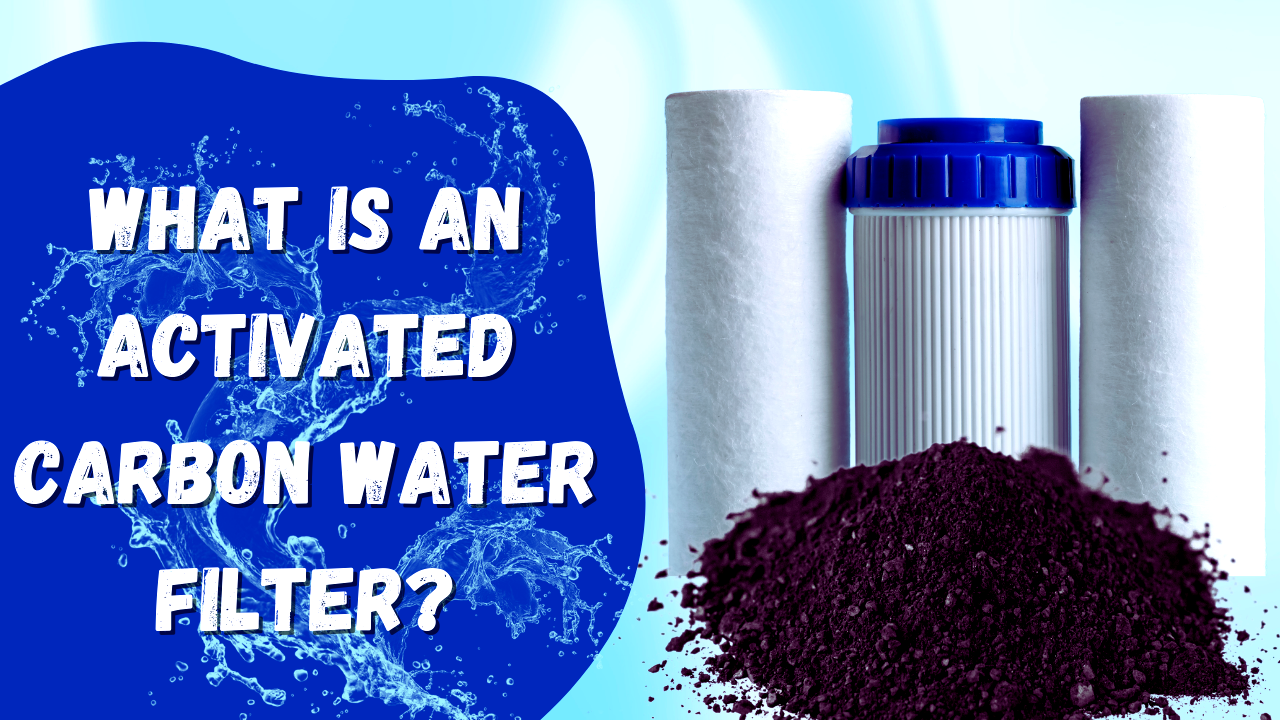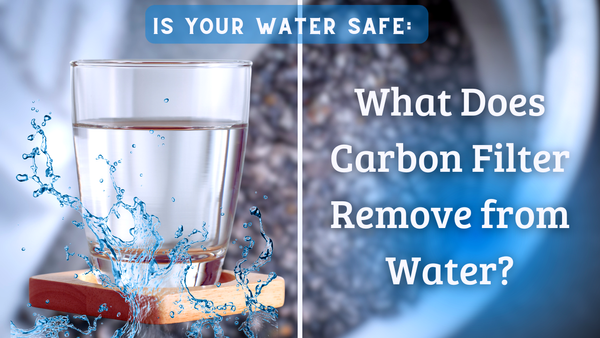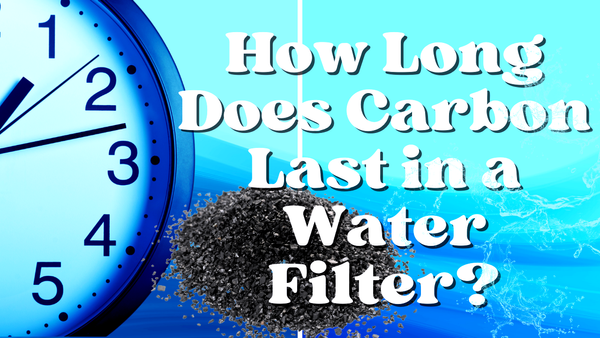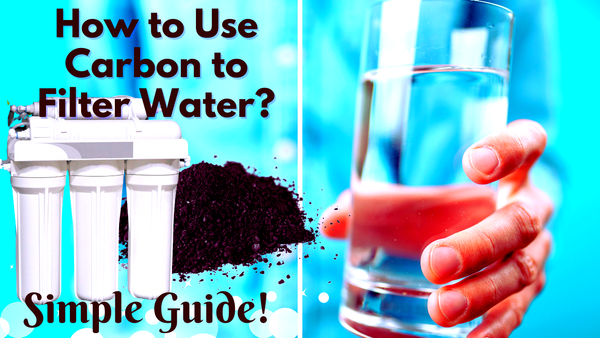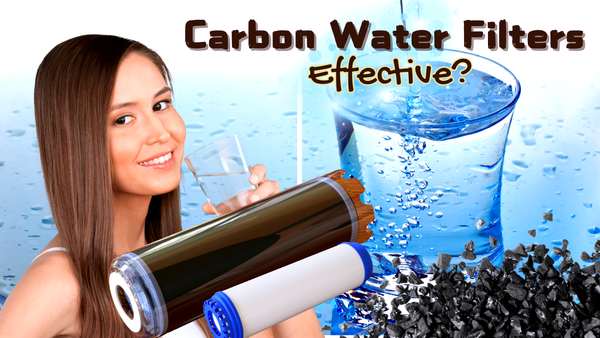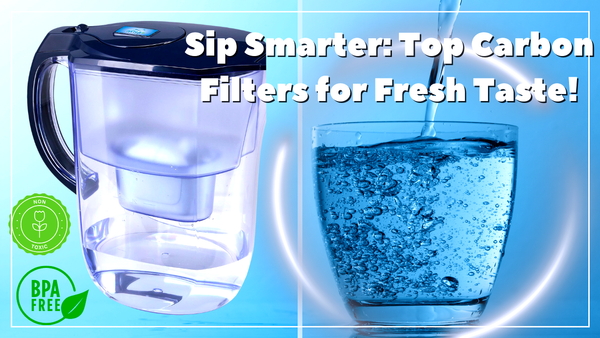Key Takeaways:
- Activated carbon water filters remove many contaminants from water, including chlorine, volatile organic compounds, and heavy metals.
- They use adsorption to trap impurities, making water safer to drink.
- Activated carbon filters come in different forms, including granular activated carbon (GAC) and carbon block filters, each with benefits. Carbon block filters, especially those with sub-micron ratings, are great at removing specific contaminants like lead and cysts.
Activated carbon water filters are a popular way to improve drinking water quality. They remove a multitude of contaminants, making water safer to drink. But what is an activated carbon water filter and how does it work?
In short, an activated carbon water filter uses a type of carbon that has been treated to increase its surface area and porosity. This treatment allows the carbon to adsorb impurities from water. Let’s get into the details.
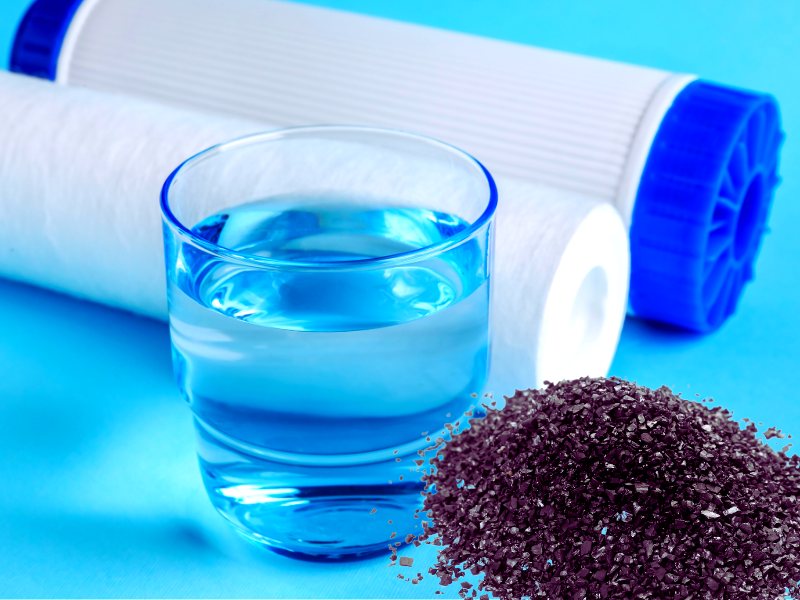
How Activated Carbon Filters Work
Activated carbon filters work through adsorption. Unlike absorption where substances are taken into the absorbing material, adsorption is where contaminants adhere to the surface of the activated carbon. This is because activated carbon has a huge surface area where contaminants can stick.
When water passes through an activated carbon filter, chlorine, volatile organic compounds (VOCs), and other impurities are trapped on the surface of the carbon particles. This removes these harmful substances from the water, making it cleaner and safer to drink.
Types of Activated Carbon Filters
There are different types of activated carbon filters, each with its benefits. The most common are granular activated carbon (GAC) filters and carbon block filters. GAC filters use loose granules of activated carbon which provides a huge surface area for adsorption. These filters are great at removing a multitude of contaminants and are often used in whole-house filters and point-of-use systems.
Carbon block filters, on the other hand, are made from compressed activated carbon. These filters have higher density and can remove smaller particles and contaminants better than GAC filters. Carbon block filters are used in drinking water filters and reverse osmosis systems. They are great at removing contaminants like lead and cysts, making them a good choice for water quality improvement. It’s best to do water quality testing to determine if you need a carbon block filter based on the contaminants in your water.
Granular Activated Carbon (GAC) Filters
Granular activated carbon (GAC) filters are one of the most popular types of activated carbon filters. These filters use loose granules of activated carbon which provides a huge surface area for adsorption. GAC filters are great at removing chlorine, volatile organic compounds (VOCs), and other impurities from water.
One of the best things about GAC filters is their flexibility. They can be used in different water filtration systems, whole-house filters, point-of-use systems, and even some air filters. They are easy to replace, making them a convenient option for many households.
Carbon Block Filters
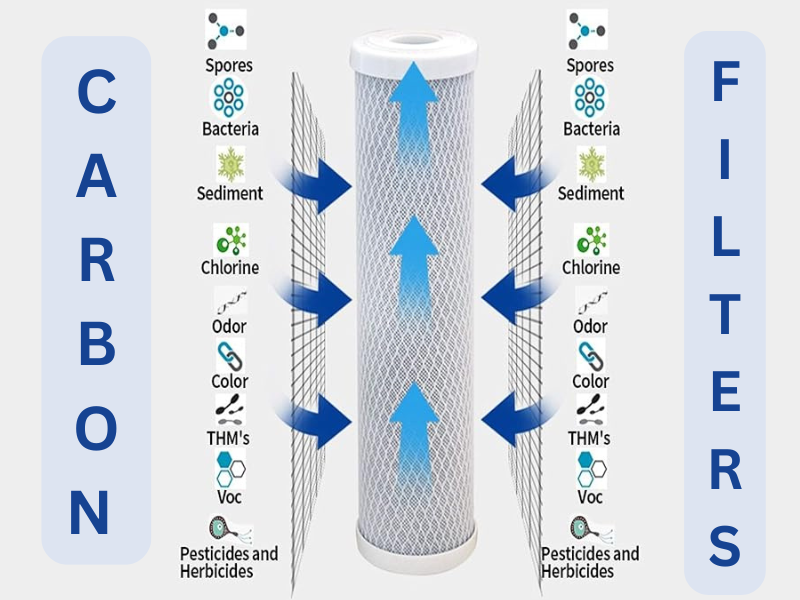
Carbon block filters are another type of activated carbon filter. These filters are made from compressed activated carbon which gives them higher density and can remove smaller particles and contaminants better than GAC filters. Carbon block filters are used in drinking water filters and reverse osmosis systems. They are great at removing contaminants like lead and cysts, making them a good choice for water quality improvement. It’s best to do water quality testing to determine if you need a carbon block filter based on the contaminants in your water.
One of the advantages of carbon block filters is they can remove many contaminants including chlorine, volatile organic compounds (VOCs), and heavy metals. Carbon block filters have a longer lifespan than GAC filters, making them a cost-effective option for many households.
Catalytic Carbon
Catalytic carbon is a type of activated carbon that has been treated to increase its ability to remove certain contaminants. This type of carbon is great at removing chlorine and chloramine which are commonly used as disinfectants in municipal water supplies.
Catalytic carbon filters are often used in conjunction with other types of activated carbon filters for total water treatment. These filters are best used in areas where the water supply has high levels of chlorine or chloramine as they can remove these contaminants and improve the taste and odor of the water.
Activated Carbon Filters Remove Contaminants
Activated carbon filters remove contaminants through adsorption. When water passes through the filter, pollutants like chlorine, volatile organic compounds (VOCs), and other impurities stick to the surface of the activated carbon particles. This process removes these harmful substances from the water, making it cleaner and safer to drink.
The performance of an activated carbon filter depends on several factors, including the type of carbon used, the size of the carbon particles, and the water's flow rate. In general, filters with a larger surface area and slower flow rate are better at removing contaminants.
Surface Area in Activated Carbon Filters
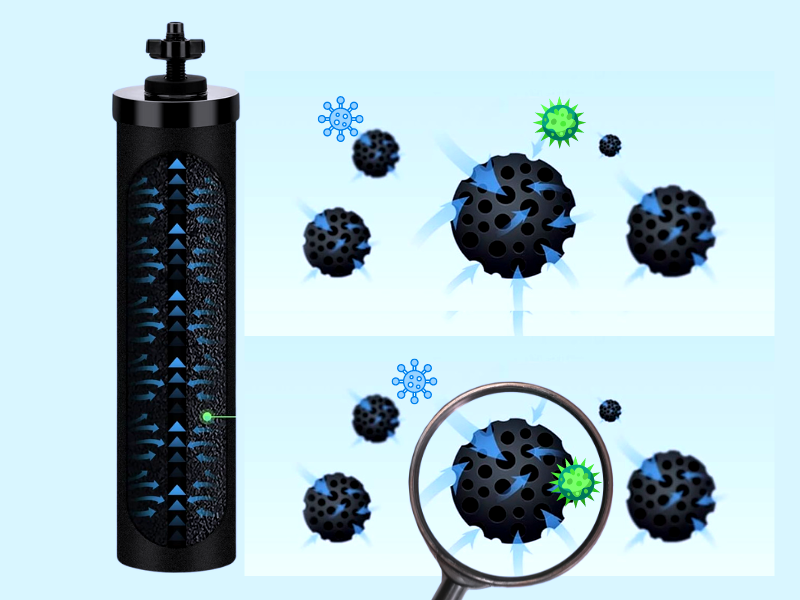
The surface area of activated carbon is a key factor in its performance as a water filter. Activated carbon has a huge surface area due to its porous structure, which provides plenty of space for contaminants to stick. This huge surface area allows activated carbon filters to remove a multitude of impurities from water.
For example, a single gram of activated carbon can have 3,000 square meters of surface area. This huge surface area allows the carbon to trap and remove contaminants like chlorine, volatile organic compounds (VOCs), and heavy metals, making the water cleaner and safer to drink.
Activated Carbon Block Filters
Activated carbon block filters are made from compressed activated carbon, which gives them higher density and allows them to remove smaller particles and contaminants better than GAC filters. These filters are used in drinking water filters and reverse osmosis systems. They are great at removing contaminants like lead and cysts, making them a good choice for improving water quality. It’s best to do water quality testing to determine if you need a carbon block filter.
One advantage of activated carbon block filters is that they can remove many contaminants, including chlorine, volatile organic compounds (VOCs), and heavy metals. Carbon block filters also have a longer lifespan than GAC filters, making them a cost-effective option for many households.
The Importance of Water Flow Rate
The flow rate of water through an activated carbon filter is a crucial factor. A slower flow rate generally means more contact time between the water and the activated carbon, which increases the chances of contaminants being adsorbed.
But you have to balance the flow rate with practicality. A slower flow rate can improve filtration, but it can also reduce water pressure and prolong the wait time for filtered water. Finding the right balance between flow rate and filtration effectiveness is key to getting the most out of an activated carbon water filter.
Activated Carbon and Reverse Osmosis Systems
Activated carbon filters are often used with reverse osmosis systems for total water treatment. Reverse osmosis systems use a semi-permeable membrane to remove a multitude of contaminants from water, including total dissolved solids (TDS), heavy metals, and microbiological contaminants.
Using an activated carbon filter with a reverse osmosis system, you can remove organic and inorganic contaminants from your water. The activated carbon filter removes chlorine, volatile organic compounds (VOCs), and other impurities, while the reverse osmosis membrane removes dissolved solids and other contaminants.
The Benefits of Coconut Shell Activated Carbon

Coconut shell-activated carbon is popular for water filtration because of its high porosity and huge surface area. This type of activated carbon is made from coconut shells, which are renewable and sustainable resources.
Coconut shell-activated carbon can remove many contaminants, including chlorine, volatile organic compounds (VOCs), and heavy metals. It has a longer lifespan than other types of activated carbon, making it a cost-effective option for many households.
Activated Carbon and Chlorine Removal
One of the main uses of activated carbon filters is to remove chlorine from water. Chlorine is used as a disinfectant in municipal water supplies, but it can give water an unpleasant taste and odor. Activated carbon filters can remove chlorine by adsorbing the chlorine molecules onto the surface of the carbon particles.
Activated carbon filters are vital tools for water safety and quality. Besides improving the taste and odor of water, removing chlorine can also reduce the formation of harmful byproducts such as trihalomethanes (THMs), which form when chlorine reacts with organic matter in the water.
Activated Carbon and Volatile Organic Compounds (VOCs)
Volatile organic compounds (VOCs) are chemicals found in water supply. These compounds can come from various sources, including industrial processes, agricultural runoff, and household products. VOCs are harmful to health, so it’s important to remove them from drinking water.
Activated carbon filters can remove VOCs from water. The huge surface area of activated carbon provides enough space for VOCs to adsorb, hence removing them from the water. This makes activated carbon filters a vital tool for water safety and quality.
Activated Carbon and Heavy Metals
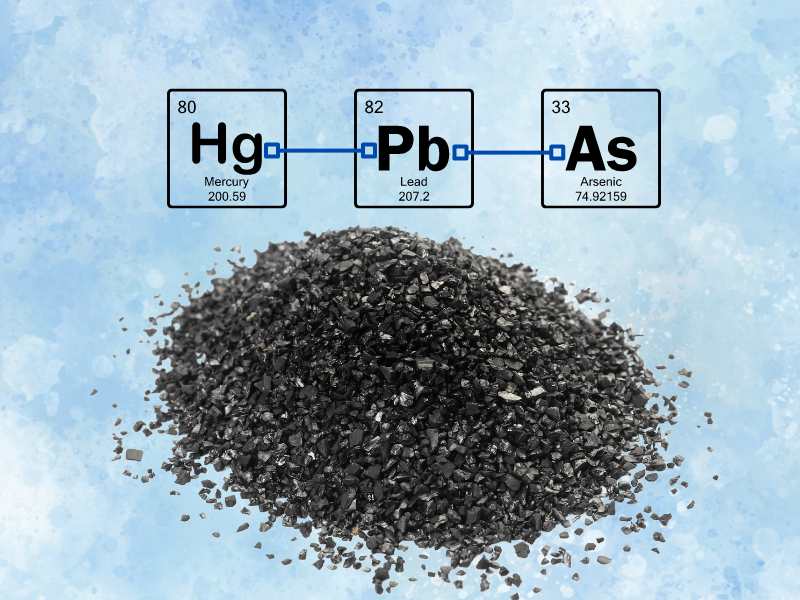
Heavy metals like lead, mercury, and arsenic can be found in water supply and can harm health. Removing these contaminants from drinking water is key to safe and clean water.
Activated carbon filters can remove heavy metals from water through adsorption. The huge surface area of activated carbon provides enough space for heavy metals to adsorb, hence removing them from the water. This makes activated carbon filters a vital tool for water safety and quality.
Activated Carbon and Chemical Reactions
Activated carbon filters remove contaminants through a process called adsorption, which involves chemical reactions between the contaminants and the surface of the activated carbon. These chemical reactions allow the contaminants to adhere to the surface of the carbon particles, effectively removing them from the water.
The effectiveness of an activated carbon filter depends on several factors, including the type of carbon used, the size of the carbon particles, and the flow rate of the water. In general, filters with a larger surface area and slower flow rate are more effective at removing contaminants.
Activated Carbon and Organic Chemicals
Organic chemicals, such as pesticides, herbicides, and pharmaceuticals, can be found in water supplies and can have harmful effects on health. Removing these contaminants from drinking water is essential for ensuring safe and clean water.
Activated carbon filters are highly effective at removing organic chemicals from water. The large surface area of activated carbon provides ample space for organic chemicals to adhere, effectively removing them from the water. This makes activated carbon filters an important tool for improving the safety and quality of drinking water.
Activated Carbon and Microbiological Contaminants
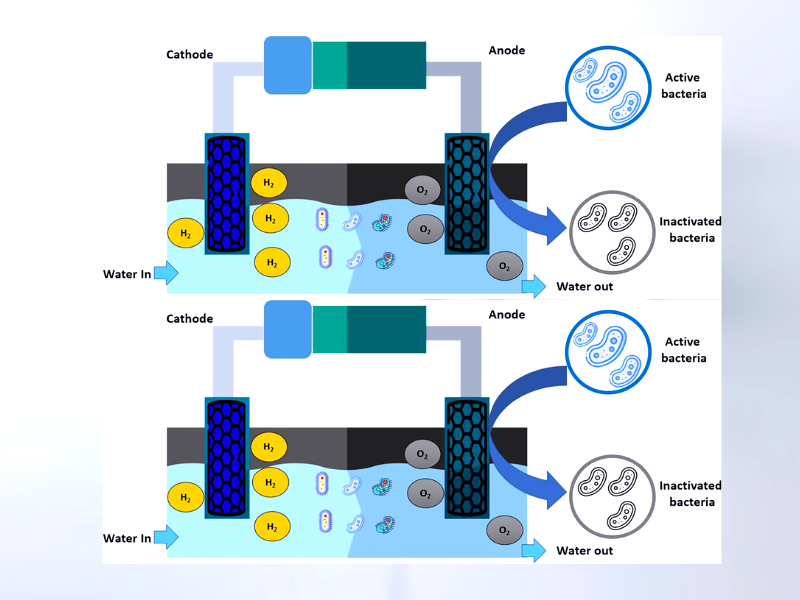
Microbiological contaminants, such as bacteria, viruses, and protozoa, can be found in water supplies and can have harmful effects on health. Removing these contaminants from drinking water is essential for ensuring safe and clean water.
While activated carbon filters are not typically used as the primary method for removing microbiological contaminants, they can be used in combination with other water treatment methods, such as reverse osmosis and ultraviolet (UV) disinfection, to provide comprehensive water treatment. The activated carbon filter removes organic contaminants, while the other treatment methods remove microbiological contaminants.
Activated Carbon and Sediment Filters
Sediment filters are used to remove larger particles, such as sand, silt, and rust, from water. These filters are often used as pre-filters in water filtration systems to protect the activated carbon filter and other components from clogging.
Using a sediment filter in combination with an activated carbon filter can provide comprehensive water treatment. The sediment filter removes larger particles, while the activated carbon filter removes smaller contaminants, such as chlorine, volatile organic compounds (VOCs), and heavy metals.
Summary
Activated carbon water filters are a powerful and versatile tool for water quality improvement. These filters use adsorption to trap and remove a wide range of contaminants including chlorine, volatile organic compounds (VOCs), and heavy metals. Activated carbon filters come in different forms like granular activated carbon (GAC) and carbon block filters each with its advantages.
Now that you know how activated carbon filters work and their benefits, you can decide which water filtration system is best for you. Whether you want to improve the taste and odor of your water, remove contaminants, or do total water treatment, activated carbon filters are part of any water filtration system. To keep up with the latest water filter tips and offers, subscribe to our newsletter today!
FAQ
How often should I replace my activated carbon water filter?
The frequency of replacing an activated carbon water filter depends on several factors including the type of filter, water quality, and amount of water filtered. Generally, it is recommended to replace activated carbon filters every 6 to 12 months. But follow the manufacturer’s guidelines for your specific filter.
Can activated carbon filters remove fluoride from water?
Activated carbon filters can’t remove fluoride from water. Fluoride is a small inorganic molecule that doesn’t adsorb well on activated carbon. If you want to remove fluoride from your water, consider using a reverse osmosis system or a fluoride filter.
Are activated carbon filters safe to use?
Yes, activated carbon filters are safe to use and are used in water filtration systems to improve drinking water quality. Activated carbon is a natural and non-toxic material that removes a wide range of contaminants from water. But make sure to replace the filter regularly to ensure it still works well.
